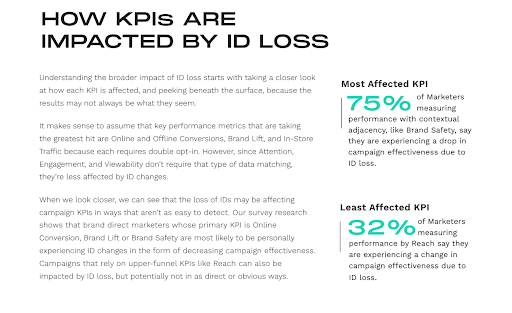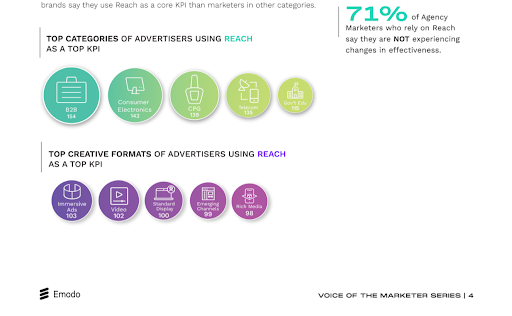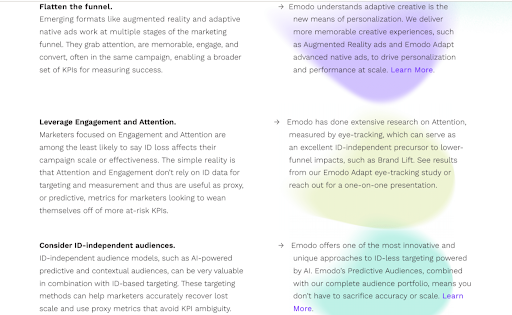
By now, we are all well aware of the drastic effects that mounting privacy regulations have on the ad tech industry.
For advertisers, the loss of identifiers and signals has significantly altered their campaign outcomes and KPIs. We all know this to be true, but maybe just not how much.
Thankfully, Emodo Institute took a deep dive into the wonderful world of marketer KPIs to showcase just how dramatically they were affected by cookie and ID loss. Most notably, the study uncovered that out of all the metrics advertisers use to measure campaign effectiveness, only engagement and attention appear to be the least impacted. So maybe there’s something to the argument that attention metrics will be a key measure for advertisers once the cookie finally takes its final breath.
In a three-part study, Emodo focused on targeting and the impact of ID loss on creative. And finally, they challenged the industry to rework how they determine campaign success. In short, KPIs will need to change because measurement, attribution, signal loss, and device IDs have evolved. Here’s what the report highlights:
- The door is open for brand categories’ KPI priorities to see severe impacts.
- The types of creative formats marketers are utilizing to achieve each KPI.
- The effect of ID changes on agencies vs. in-house agencies.
- The at-risk KPIs marketers have already seen affected by ID loss and more.
“Many marketers are starting to grasp the significance of ID loss, but much of the focus tends to be on targeting,” said Megan Saunders, SVP of Global Marketing & Growth at Emodo. “The impact on measurement is potentially even more severe, but that element is not as widely understood. Advertisers need to rethink how they evaluate their campaigns’ success.”
ID Loss’s Impact on KPIs
Emodo’s research found that marketers whose primary KPIs are online conversion, brand lift, or brand safety are more likely to experience less campaign effectiveness due to ID loss. In theory, this happens because each step requires a double opt-in.
According to the study, “consumers have to be ID’d on the ad impression, and then subsequently on the transaction, store visit, or another measured event. Then those two events need to be matched to attribute the action to the ad impression. That means if an opt-in rate is 20%, then the double opt-in rate could be as low as 4%.”
On the other hand, campaigns that rely on upper-funnel KPIs like reach experienced less of a negative impact due to ID loss. Only 32% of marketers measuring by reach cited impact because of ID loss. 75% of marketers measuring performance with contextual adjacency like Brand Safety cited impact due to ID loss.
Reach: Less Effect Does Not Mean No Effect
As mentioned above, marketers who focus on reach as a KPI assert that they are less likely to experience the impact of ID loss. Yet, if you take out the magnifying glass and examine it closer, findings show that reach data is sometimes logged inaccurately. Campaign reach often looks larger than it really is because ID loss misrepresents some impressions as incremental reach.
Reach might not be as protected as it seems because “Without ID data, impressions from the same device can’t be mapped back to each other, resulting in duplicative impressions that are inaccurately interpreted as incremental reach, creating a false sense of scale.”
Accuracy is key and any remnants of duplicate impressions should be accounted for. Lack of precision will negatively impact your campaign and it is important that duplicated impressions are discounted. It ensures “you are using a more accurate figure for the amount of valid impressions served.”
The effect, albeit minimal, should still be examined if reach is one of your major KPIs.
Marketers reported using reach as a KPI the most: CPG, Telecom, Consumer Electronics, and B2B.
Viewability and Brand Safety: The Effect of Companion KPIs
KPIs like viewability and brand safety might not require an ID for measurement purposes, but they are often linked to a KPI impacted by ID changes.
For instance, marketers focused on viewability usually have one other companion KPI, such as attention or reach. Even brand safety, a KPI that does not require a double opt-in, reports a high adverse effect of campaign quality due to ID loss because of its companion KPIs.
Here’s what the study found:
- Viewability: 84% of agency marketers who rely on viewability say they are NOT experiencing any ID-related changes in the effectiveness of their campaigns.
- Brand safety: 88% of brand direct marketers who rely on brand safety say they ARE experiencing ID-related changes in the effectiveness of their campaigns.
Further Considerations: There is Still Hope with ID Loss
The loss of IDs and cookies does not mean your campaigns will not be as effective as they used to be. It means it’s time to evolve how you measure campaign effectiveness.
The Emodo study suggests three tactics to increase your opportunities:
Flatten the funnel: Emerging formats like augmented reality and adaptive native ads work at multiple marketing funnel stages.
Leverage engagement and attention: Marketers focused on engagement and attention are the least likely to say ID loss affects their campaign scale or effectiveness.
Consider ID-independent audiences: ID-independent audience models, such as AI-powered predictive and contextual audiences, can be precious in combination with ID-based targeting.
“Each advertiser should look past the surface of their campaigns to make sure that ID loss doesn’t have a greater impact than they realize,” suggests Emodo. “It’s important to note it’s in the interest of measurement providers to project that ID loss is having minimal impact, even when that might not be the entire story.”
You can read the full study here.


